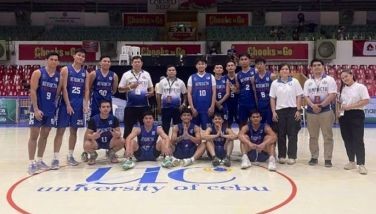Rustan’s Coffee Corp.; A whole lot of brew
August 20, 2001 | 12:00am
The smell of coffee is never far from Emmanuel Lopez, chief operating officer of Rustan’s Coffee Corp. It’s inside his third floor office where guests are served hot or iced Starbucks coffee. It’s inside his car where an open can of coffee beans masks the smell of cigarettes.
"I can’t smoke inside a Starbucks store. Nobody can. That would detract from enjoying the aroma of coffee that is part of the Starbucks experience," Lopez said. For the same reason, cleaning products used in all 32 outlets of Rustan’s Coffee are unscented and store employees are not allowed to wear cologne or perfume.
Store employees are called partners, one of the conditions set by Starbucks Coffee International when it signed a licensing agreement with Rustan’s Coffee in 1997. "They were looking for a local company that had retail expertise and a corporate culture of strong values," Lopez said.
Rustan’s Coffee is a 700-man strong company, 600 of whom are partners. Before a partner faces the customer, he or she undergoes a 24-hour training program that is partly a crash course on coffee knowledge and partly a charm school on how to deal with customers in a friendly but firm manner. The coffee knowledge is supplied by managers who trained at the Starbucks Support Center in Seattle. The training on customer service is handled by old hands who learned the ropes from Lopez’s grandmother, the late Gliceria Tantoco.
"The Rustan’s culture is very people-oriented. We are all members of one closely-knit family," said Lopez. "We treat our partners with respect and dignity, not because it makes good business sense but because it’s the right thing to do," he added, echoing the HRD philosophy of Starbucks Coffee chairman and chief executive officer Howald Schultz.
Rustan’s Coffee opened its first Starbucks outlet at the back of 6750 Bldg., across the Shangri-la Hotel in time for the 1997 Christmas season. "We thought that if it didn’t work there, it wouldn’t work anywhere else in the country," Lopez said. "We had multinationals like Procter & Gamble and Caltex Phils. in the same building; we had tourists from the hotel; we had the Makati crowd. These were the people who would be most open to paying a premium price for good coffee."
In the next three and a half years, Rustan’s Coffee opened stores in areas where people live, work and play. Except for one in Bulacan, all the stores are located in Metro Manila. All the stores are also company-owned, following the strategy of Starbucks Coffee Co. in the US Mainland.
"We don’t see our growth strategy as an either/or," said Lopez. "It’s not a choice of growing slower if all the stores are company owned or growing faster through franchising. We feel that we can control the business better if we own the business 100%. We will grow at a faster pace when we think we’re ready."
By the end of the year, Lopez sees the number of Starbucks stores increasing to 40. "We have a business expansion plan that’s flexible. At the end of the day, however, it’s Rustan’s money and the family will decide how much more it wants to invest into the business."
The peso-dollar rate is a key factor in any future investment decision. At the time Rustan’s Coffee signed up with Starbucks, the foreign exchange rate was P36 to the dollar. Today, the peso hovers at between P51 and P52 to the dollar.
Importation costs are high. Rustan’s Coffee imports all of its coffee beans from Seattle. The exception is an arabica grown in Bukidnon, which form the basis for the first localized Starbucks coffee outside the US Mainland. Called the Caffe Vinta, the packaging was designed by national artist, Malang. "We haven’t been very busy in pushing the Philippine-made coffee," admitted Lopez. "We have to fight the Filipino customer, who prefer the better known coffee beans of the Americans. It’s sad because the customer will never know how good the Philippine coffee is until he tries it."
Slowly, Rustan’s Coffee has been trying to source out locally some of its supplies, in part to conserve on dollar purchases and in part to show national pride in locally made products. Fresh milk is now purchased from Batangas. The company is, however, still looking for the local equivalent of the heavy-duty napkins made from recycled paper.
Everything that’s eaten in the stores are, however, all made locally. Rustan’s Coffee deals with a small group of suppliers who have demonstrated product freshness and consistency. It is the supplier who delivers the food to all Starbucks stores everyday.
"We’re currently working out the kinks in our delivery system," said Lopez, who admitted that some stores run out of a particular food item which cannot be replenished by the supplier until the next day while some stores are unable to sell all the food items for the day. Day-old food is given away to the local community the Starbucks store serves.
Given the absence of a commissary, Rustan’s Coffee must, at the very least, work out a more reliable inventory system that would determine how much food each store would require for the day. Right now, stores which run out of a particular item canvass other nearby stores and "borrow" their excess.
At the end of the day, however, Rustan’s Coffee is selling the total Starbucks experience. "We’re not just selling good coffee; we’re selling ambiance. We’re selling a perception–that Starbucks coffee drinkers are young and hip. For a cup of coffee, that’s a cheap price to pay for instant prestige," said Lopez.
"I can’t smoke inside a Starbucks store. Nobody can. That would detract from enjoying the aroma of coffee that is part of the Starbucks experience," Lopez said. For the same reason, cleaning products used in all 32 outlets of Rustan’s Coffee are unscented and store employees are not allowed to wear cologne or perfume.
Store employees are called partners, one of the conditions set by Starbucks Coffee International when it signed a licensing agreement with Rustan’s Coffee in 1997. "They were looking for a local company that had retail expertise and a corporate culture of strong values," Lopez said.
Rustan’s Coffee is a 700-man strong company, 600 of whom are partners. Before a partner faces the customer, he or she undergoes a 24-hour training program that is partly a crash course on coffee knowledge and partly a charm school on how to deal with customers in a friendly but firm manner. The coffee knowledge is supplied by managers who trained at the Starbucks Support Center in Seattle. The training on customer service is handled by old hands who learned the ropes from Lopez’s grandmother, the late Gliceria Tantoco.
"The Rustan’s culture is very people-oriented. We are all members of one closely-knit family," said Lopez. "We treat our partners with respect and dignity, not because it makes good business sense but because it’s the right thing to do," he added, echoing the HRD philosophy of Starbucks Coffee chairman and chief executive officer Howald Schultz.
In the next three and a half years, Rustan’s Coffee opened stores in areas where people live, work and play. Except for one in Bulacan, all the stores are located in Metro Manila. All the stores are also company-owned, following the strategy of Starbucks Coffee Co. in the US Mainland.
"We don’t see our growth strategy as an either/or," said Lopez. "It’s not a choice of growing slower if all the stores are company owned or growing faster through franchising. We feel that we can control the business better if we own the business 100%. We will grow at a faster pace when we think we’re ready."
By the end of the year, Lopez sees the number of Starbucks stores increasing to 40. "We have a business expansion plan that’s flexible. At the end of the day, however, it’s Rustan’s money and the family will decide how much more it wants to invest into the business."
Importation costs are high. Rustan’s Coffee imports all of its coffee beans from Seattle. The exception is an arabica grown in Bukidnon, which form the basis for the first localized Starbucks coffee outside the US Mainland. Called the Caffe Vinta, the packaging was designed by national artist, Malang. "We haven’t been very busy in pushing the Philippine-made coffee," admitted Lopez. "We have to fight the Filipino customer, who prefer the better known coffee beans of the Americans. It’s sad because the customer will never know how good the Philippine coffee is until he tries it."
Slowly, Rustan’s Coffee has been trying to source out locally some of its supplies, in part to conserve on dollar purchases and in part to show national pride in locally made products. Fresh milk is now purchased from Batangas. The company is, however, still looking for the local equivalent of the heavy-duty napkins made from recycled paper.
Everything that’s eaten in the stores are, however, all made locally. Rustan’s Coffee deals with a small group of suppliers who have demonstrated product freshness and consistency. It is the supplier who delivers the food to all Starbucks stores everyday.
"We’re currently working out the kinks in our delivery system," said Lopez, who admitted that some stores run out of a particular food item which cannot be replenished by the supplier until the next day while some stores are unable to sell all the food items for the day. Day-old food is given away to the local community the Starbucks store serves.
Given the absence of a commissary, Rustan’s Coffee must, at the very least, work out a more reliable inventory system that would determine how much food each store would require for the day. Right now, stores which run out of a particular item canvass other nearby stores and "borrow" their excess.
At the end of the day, however, Rustan’s Coffee is selling the total Starbucks experience. "We’re not just selling good coffee; we’re selling ambiance. We’re selling a perception–that Starbucks coffee drinkers are young and hip. For a cup of coffee, that’s a cheap price to pay for instant prestige," said Lopez.
BrandSpace Articles
<
>
- Latest
Latest
Latest
November 5, 2024 - 9:50am
November 5, 2024 - 9:50am
October 16, 2024 - 4:00pm
By Aian Guanzon | October 16, 2024 - 4:00pm
October 1, 2024 - 9:00am
October 1, 2024 - 9:00am
September 27, 2024 - 4:00pm
September 27, 2024 - 4:00pm
September 12, 2024 - 2:10pm
September 12, 2024 - 2:10pm
Recommended
November 26, 2024 - 12:00am




























